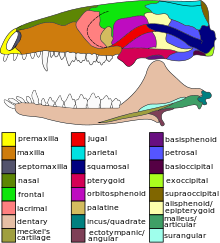
In the human skull, the zygomatic bone, also called cheekbone or malar bone, is a paired irregular bone, situated at the upper and lateral part of the face and forms part of the lateral wall and floor of the orbit, of the temporal fossa and the infratemporal fossa. It presents a malar and a temporal surface; four processes, and four borders.

In anatomy, the zygomatic arch, or cheek bone, is a part of the skull formed by the zygomatic process of the temporal bone and the temporal process of the zygomatic bone, the two being united by an oblique suture ; the tendon of the temporal muscle passes medial to the arch, to gain insertion into the coronoid process of the mandible (jawbone).
The quadratojugal is a skull bone present in many vertebrates, including some living reptiles and amphibians.

Archosauromorpha is a clade of diapsid reptiles containing all reptiles more closely related to archosaurs rather than lepidosaurs. Archosauromorphs first appeared during the late Middle Permian or Late Permian, though they became much more common and diverse during the Triassic period.

Ouranosaurus is a genus of herbivorous basal hadrosauriform dinosaur that lived during the Aptian stage of the Early Cretaceous of modern-day Niger and Cameroon. Ouranosaurus measured about 7–8.3 metres (23–27 ft) long and weighed 2.2 metric tons. Two rather complete fossils were found in the Elrhaz Formation, Gadoufaoua deposits, Agadez, Niger, in 1965 and 1970, with a third indeterminate specimen known from the Koum Formation of Cameroon. The animal was named in 1976 by French paleontologist Philippe Taquet; the type species being Ouranosaurus nigeriensis. The generic name is a combination of ourane, a word with multiple meanings, and sauros, the Greek word for lizard. The specific epithet nigeriensis alludes to Niger, its country of discovery. And so, Ouranosaurus nigeriensis could be interpreted as "brave lizard originating from Niger".
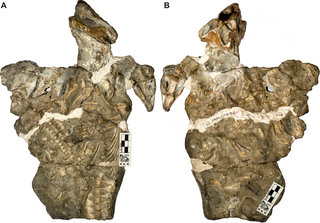
Galesaurus is an extinct genus of carnivorous cynodont therapsid that lived between the Induan and the Olenekian stages of the Early Triassic in what is now South Africa. It was incorrectly classified as a dinosaur by Sir Richard Owen in 1859.
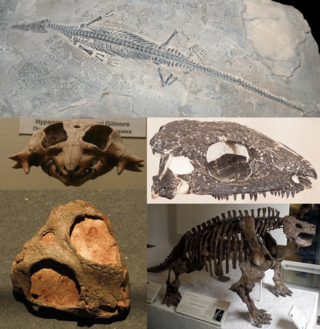
Parareptilia ("near-reptiles") is an extinct subclass or clade of basal sauropsids/reptiles, typically considered the sister taxon to Eureptilia. Parareptiles first arose near the end of the Carboniferous period and achieved their highest diversity during the Permian period. Several ecological innovations were first accomplished by parareptiles among reptiles. These include the first reptiles to return to marine ecosystems (mesosaurs), the first bipedal reptiles, the first reptiles with advanced hearing systems, and the first large herbivorous reptiles. The only parareptiles to survive into the Triassic period were the procolophonoids, a group of small generalists, omnivores, and herbivores. The largest family of procolophonoids, the procolophonids, rediversified in the Triassic, but subsequently declined and became extinct by the end of the period.

The squamosal is a skull bone found in most reptiles, amphibians, and birds. In fishes, it is also called the pterotic bone.
The postorbital bar is a bony arched structure that connects the frontal bone of the skull to the zygomatic arch, which runs laterally around the eye socket. It is a trait that only occurs in mammalian taxa, such as most strepsirrhine primates and the hyrax, while haplorhine primates have evolved fully enclosed sockets. One theory for this evolutionary difference is the relative importance of vision to both orders. As haplorrhines tend to be diurnal, and rely heavily on visual input, many strepsirrhines are nocturnal and have a decreased reliance on visual input.

Temporal fenestrae are openings in the temporal region of the skull of some amniotes, behind the orbit. These openings have historically been used to track the evolution and affinities of reptiles. Temporal fenestrae are commonly seen in the fossilized skulls of dinosaurs and other sauropsids. The major reptile group Diapsida, for example, is defined by the presence of two temporal fenestrae on each side of the skull. The infratemporal fenestra, also called the lateral temporal fenestra or lower temporal fenestra, is the lower of the two and is exposed primarily in lateral (side) view.

The skull roof or the roofing bones of the skull are a set of bones covering the brain, eyes and nostrils in bony fishes and all land-living vertebrates. The bones are derived from dermal bone and are part of the dermatocranium.

Microleter is an extinct genus of basal procolophonomorph parareptiles which lived in Oklahoma during the Early Permian period. The type and only known species is Microleter mckinzieorum. Microleter is one of several parareptile taxa described from the Richards Spur fissure fills, and can be characterized from its high tooth count, lacrimal/narial contact, short postfrontal, and slit-like temporal emargination edged by the postorbital, jugal, squamosal, and quadratojugal. Contrary to Australothyris, which had a similar phylogenetic position as a basal procolophonomorph, Microleter suggests that early parareptile evolution occurred in Laurasia and that multiple lineages developed openings or emarginations in the temporal region.

Jesairosaurus is an extinct genus of early archosauromorph reptile known from the Illizi Province of Algeria. It is known from a single species, Jesairosaurus lehmani. Although a potential relative of the long-necked tanystropheids, this lightly-built reptile could instead be characterized by its relatively short neck as well as various skull features.

Palatodonta is an extinct genus of neodiapsid reptile known from the early Middle Triassic of the Netherlands. It was initially described in 2013 as a basal placodontiform closely related to a group of marine reptiles called placodonts, characterized by their crushing teeth and shell-like body armor. Under this interpretation, Palatodonta is transitional between placodonts and less specialized reptiles. Like placodonts, it has a row of large teeth on its palate, but while these teeth are thick and blunt in placodonts, Palatodonta has palatal teeth that are thin and pointed. A 2023 study instead classified it as a sauropterygomorph and the sister taxon to Eusaurosphargis. In other words, it is close to, but not within, Sauropterygia.
This glossary explains technical terms commonly employed in the description of dinosaur body fossils. Besides dinosaur-specific terms, it covers terms with wider usage, when these are of central importance in the study of dinosaurs or when their discussion in the context of dinosaurs is beneficial. The glossary does not cover ichnological and bone histological terms, nor does it cover measurements.
Triopticus is a genus of archosauriform reptile from the Late Triassic of Texas, United States. It contains a single species, Triopticus primus, described in 2016 by Stocker et al. It has an unusually domed head reminiscent of the later pachycephalosaurian dinosaurs in an example of convergent evolution.
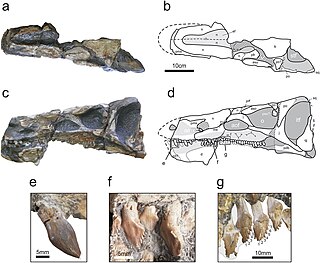
Isaberrysaura is a genus of stegosaurian ornithischian dinosaur from the Middle Jurassic Los Molles Formation of Patagonia, Argentina. The genus contains a single species, I. mollensis, described by Salgado et al. in 2017 from a single specimen. Although initially classified as a basal neornithischian, subsequent analysis has allied it with the Stegosauria; the morphology of its skull resembles those of other members of the group.
Shuangbaisaurus is genus of theropod dinosaur, possibly a junior synonym of Sinosaurus. It lived in the Early Jurassic of Yunnan Province, China, and is represented by a single species, S. anlongbaoensis, known from a partial skull. Like the theropods Dilophosaurus and Sinosaurus,Shuangbaisaurus bore a pair of thin, midline crests on its skull. Unusually, these crests extended backwards over the level of the eyes, which, along with the unusual orientation of the jugal bone, led the describers to name it as a new genus. However, Shuangbaisaurus also possesses a groove between its premaxilla and maxilla, a characteristic which has been used to characterize Sinosaurus as a genus. Among the two morphotypes present within the genus Sinosaurus, Shuangbaisaurus more closely resembles the morphotype that is variably treated as a distinct species, S. sinensis, in its relatively tall skull.
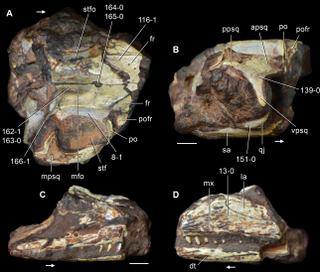
Kadimakara is an extinct genus of early archosauromorph reptile from the Arcadia Formation of Queensland, Australia. It was seemingly a very close relative of Prolacerta, a carnivorous reptile which possessed a moderately long neck. The generic name Kadimakara references prehistoric creatures from Aboriginal myths which may have been inspired by ice-age megafauna. The specific name K. australiensis relates to the fact that it was found in Australia. Prolacerta and Kadimakara were closely related to the Archosauriformes, a successful group which includes archosaurs such as crocodilians, pterosaurs, and dinosaurs.
Eurycephalosuchus is an extinct genus of orientalosuchine alligatoroid from the Late Cretaceous Jiangxi Province of China. Known from a well preserved skull and mandible alongside various postcranial remains, Eurycephalosuchus possessed a short and broad skull with a very short skulltable. Eurycephalosuchus lived with at least one other crocodilian, an indetermined member of the clade Brevirostres. The genus is monotypic, containing only the species Eurycephalosuchus gannanensis.


